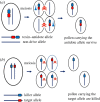Gene drives in plants: opportunities and challenges for weed control and engineered resilience
- PMID: 31551052
- PMCID: PMC6784734
- DOI: 10.1098/rspb.2019.1515
Gene drives in plants: opportunities and challenges for weed control and engineered resilience
Abstract
Plant species, populations and communities are under threat from climate change, invasive pathogens, weeds and habitat fragmentation. Despite considerable research effort invested in genome engineering for crop improvement, the development of genetic tools for the management of wild plant populations has rarely been given detailed consideration. Gene drive systems that allow direct genetic management of plant populations via the spread of fitness-altering genetic modifications could be of great utility. However, despite the rapid development of synthetic tools and their enormous promise, little explicit consideration has been given to their application in plants and, to date, they remain untested. This article considers the potential utility of gene drives for the management of wild plant populations, and examines the factors that might influence the design, spread and efficacy of synthetic drives. To gain insight into optimal ways to design and deploy synthetic drive systems, we investigate the diversity of mechanisms underlying natural gene drives and their dynamics within plant populations and species. We also review potential approaches for engineering gene drives and discuss their potential application to plant genomes. We highlight the importance of considering the impact of plant life-history and genetic architecture on the dynamics of drive, investigate the potential for different types of resistance evolution, and touch on the ethical, regulatory and social challenges ahead.
Keywords: ecology; evolution; genetic management; life-history; meiotic drive; resistance.
Conflict of interest statement
We declare we have no competing interests.
Figures



References
Publication types
MeSH terms
Associated data
LinkOut - more resources
Full Text Sources

